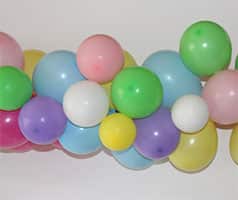 A garland is an open wreath of branches or flowers that is fastened to the head or placed around the neck. It is an accessory that is usually worn in celebrations and rituals. The concept can also refer to a strip that is hung as ornamentation.
A garland is an open wreath of branches or flowers that is fastened to the head or placed around the neck. It is an accessory that is usually worn in celebrations and rituals. The concept can also refer to a strip that is hung as ornamentation.
For example: “When we arrived on the island, a local resident placed a flower garland for us as a welcome” , “We are going to decorate the house with colorful garlands for your birthday party” , “The dancers danced waving their garlands at the rhythm of music.”
Garlands are very important in Hawaiian culture . In the Hawaiian archipelago, a garland or lei is a necklace often given to visitors. It is a strip that allows you to decorate the neck .
Hawaiian garlands are generally made with fresh leaves and flowers. However, there are also garlands made of feathers or shells, among other natural materials, or even paper, fabric, etc. A Hawaiian garland, in short, is a type of decoration that is given as a symbol of affection , congratulations or recognition.
Beyond Hawaii , garlands are often hung from walls, doors or windows to decorate a room for a special occasion. It is common that, at a birthday celebration, garlands are installed with the name of the honoree or with expressions such as “Happy birthday” or “Congratulations” .
These garlands can be made with cardboard, paper or plastic, to name a few possibilities. They are usually colorful so that they convey joy and warmth. Although we can buy garlands made in a specialized store or in a supermarket, today it is very easy to make them at home, with inexpensive materials, to create a completely personalized design.
 If we are planning a birthday party for a loved one, for example, we surely know their tastes, characters and favorite colors, and that is why we have the opportunity to make some garlands that include them to put a smile on their face as soon as they see them. As with almost all handmade products, our limits are creativity and manual skills, which means we have a large number of possibilities in front of us.
If we are planning a birthday party for a loved one, for example, we surely know their tastes, characters and favorite colors, and that is why we have the opportunity to make some garlands that include them to put a smile on their face as soon as they see them. As with almost all handmade products, our limits are creativity and manual skills, which means we have a large number of possibilities in front of us.
One of the advantages we have from the beginning is that there are no unbreakable rules when making a garland: as long as it meets the fundamental definition, provided in the first paragraphs of this article, it is enough. For this reason, we can let our imagination run wild for both motifs and patterns . For example, one in which the same figure is repeated indefinitely is valid as well as a very varied one. In addition, between one piece and another we can include smaller parts that act as "separators", a good idea to give more movement to the final product.
Let's think of a garland with a "fruity" design, which consists of a series of paper fruits. One possibility is to determine which species we will include, make several copies of each one, and then attach them to the rope. On the other hand, we can also create a piece that articulates the garland, a separator, which can be a smaller fruit (like a cherry, for example) or even a basic geometric shape, such as a circle or a rhombus; In this way, we could place separate fruit sets harmoniously.
For garlands with text messages there are also many possibilities, ranging from cut out letters to rectangles on which they are drawn with a marker. You can also use balloons instead of pieces of paper, or create more complex, three-dimensional objects, although this requires a level of skill that not all of us have.
